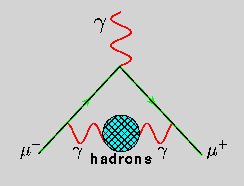

RESEARCH AND TRAINING OBJECTIVES
DESY Zeuthen/Universität Karlsruhe Team
One of the challenges of Daphne is presented by the measurement of the
total e+e- hadronic cross-section, which,
through the optical theorem, can give information on the hadronic
contributions to
![]() QED(MZ0) and
(g-2)µ. Considerations from precision physics suggest
that the goal should be to measure the cross-section at the level of a
few percent. This could allow a reduction of the error on
aµ such as to be closer to the contribution from virtual
light-by-light scattering. To extract the total cross-section a
certain amount of modeling is necessary, since, in contrast to LEP, at
low energies the theoretical shape of the total cross-section cannot be
calculated from first principles. Important cross-checks will be
obtained by studying connections between form-factor measurements at
Daphne and tau-lepton decays through isospin and SU(3) relations
between multipion final states. More information on electroweak
quantities requires models for light-by-light contributions. Various
models, such as the Hidden Symmetry Scheme and related models which
incorporate vector mesons in chiral Lagrangians, can be used to
estimate this hadronic contribution and to compare it with current
estimates.
QED(MZ0) and
(g-2)µ. Considerations from precision physics suggest
that the goal should be to measure the cross-section at the level of a
few percent. This could allow a reduction of the error on
aµ such as to be closer to the contribution from virtual
light-by-light scattering. To extract the total cross-section a
certain amount of modeling is necessary, since, in contrast to LEP, at
low energies the theoretical shape of the total cross-section cannot be
calculated from first principles. Important cross-checks will be
obtained by studying connections between form-factor measurements at
Daphne and tau-lepton decays through isospin and SU(3) relations
between multipion final states. More information on electroweak
quantities requires models for light-by-light contributions. Various
models, such as the Hidden Symmetry Scheme and related models which
incorporate vector mesons in chiral Lagrangians, can be used to
estimate this hadronic contribution and to compare it with current
estimates.
Since a limit to precision measurements in e+e-
collisions is due to the presence of QED radiative corrections, the
techniques employed for a full evaluation of these effects, will
include standard next-to-leading corrections to the second order of
QED, leading logarithmic approximations to deal with higher order
corrections, and Monte Carlo event generators for data analysis and
simulations. Monte Carlo simulations and soft photon summation
techniques will also be applied to determine the effects of infrared
radiative corrections on the precision, which is attainable in detector
calibration through QED processes like quasi-real Compton scattering.